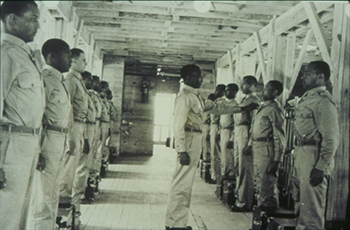 In July 2020, Navy Lt. j.g. Madeline G. Swegle, became the U.S. Navy's first Black female tactical jet aviator. Here she stands in front of a T-45C Goshawk jet trainer aircraft on the Training Air Wing 2 flight line at Naval Air Station Kingsville, Texas. (Photo by Navy Lt. Michelle Tucker.)
In July 2020, Navy Lt. j.g. Madeline G. Swegle, became the U.S. Navy's first Black female tactical jet aviator. Here she stands in front of a T-45C Goshawk jet trainer aircraft on the Training Air Wing 2 flight line at Naval Air Station Kingsville, Texas. (Photo by Navy Lt. Michelle Tucker.)
A Railroad to Freedom
For much of our nation’s history black Americans lived in slavery. In 1850 the Fugitive Slave Act imposed strict penalties on anyone caught aiding in their escape from slavery.
During this time a movement known as the Underground Railroad was underway to help black Americans escape from slavery. Former slaves, including Harriet Tubman organized this secret operation which eventually helped more than 100,000 black Americans find freedom.
In early 1863, black Americans received a taste of justice after the Emancipation Proclamation, and the subsequent 13th Amendment freed them from slavery. However, much work remained in the work of making the dream of racial justice a reality.
Protesting Injustice
In the 1950s, unjust segregation laws across the nation physically separated black and white Americans. These unjust laws required black Americans to sit at the back of buses, drink from different water fountains, use different public pools and a variety of other deprave action.
In 1955 civil rights activists Rosa Parks, Claudette Colvin, and Mary Louise Smith were arrested in Montgomery, Alabama, because they refused to give up their bus seats, which were reserved for whites. Their arrests signaled the beginning of the Montgomery Bus Boycott—a thirteen-month-long protest of segregation, when protestors chose not to ride the city’s buses.
These non-violent protests continued into the 1960s with the Freedom Riders seeking to expose segregation on buses throughout the nation.
Thanks to the efforts of these and other courageous Americans, a number of key court decisions soon declared that segregation on the nation’s buses was unconstitutional.
 The 4th Aviation Squadron was an all-black unit established at Maxwell Field in Alabama on 10 June 1941 and one of the first black units established in Alabama. (Photo courtesy of 94th Airlift Wing.)
The 4th Aviation Squadron was an all-black unit established at Maxwell Field in Alabama on 10 June 1941 and one of the first black units established in Alabama. (Photo courtesy of 94th Airlift Wing.)
History’s Greatest Demonstration
Sadly, segregation was not limited to the nation’s buses. The law required that black and white Americans use separate public facilities throughout the nation.
On 28 August 1963, a group of prominent civil rights leaders, known as the “Big Six” led more than 250,000 men and women in the March on Washington for Freedom.. ‘The March’ as it would come to be known as, was the largest recorded civil rights demonstration in United States history.
Over the next two two years, the Civil Rights Act of 1964 and the National Voting Rights Act of 1965 became law, outlawing segregation in the public square.
We Must Continue the Journey
Each of these movements successfully helped take black Americans take a major step forward along the path to racial justice. This success was made possible by individuals who were dedicated to the fight for justice.
Black History Month invites us to not only celebrate their work, but to continue this work – to stamp out injustice, to come together as Americans and make this nation a better place for all.
As, King eloquently stated on that hot summer day in 1963, “I have a dream that one day this nation will rise up and live out the true meaning of its creed-- “We hold these truths to be self-evident, that all men are created equal.”
Join the DHA community as we Speak Out Against Injustice during Black History Month! Follow us online with the hashtags #blackhistorymonth #justice, and #humanrights.
And learn more: https://www.africanamericanhistorymonth.gov/